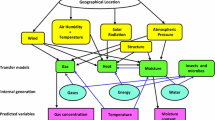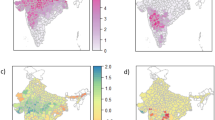Abstract
Changes in postharvest storage conditions due to climate change can directly affect energy usage and food supply and quality. However, no study has assessed climate change impacts on postharvest storage conditions in different climate regions over the contiguous United States (CONUS), a major agricultural producer around the world. The goal of this study is to assess the impact of climate change on cold storage conditions for the highest grossing crop for each of the nine climate regions within the CONUS. Storage degree days (SDDs) accumulate when ambient temperatures increase relative to crop storage base temperatures. Changes in SDDs and winter subperiod length were calculated for each regional crop using historical climate data and 20 downscaled global climate model projections. All regions project significant increases in SDD accumulation and decreases in winter subperiod length when compared with the historical reference period (1979–2005). Between years 2020 and 2080, Northwest and Northeast regions’ apples will be impacted most by SDD accumulation with yearly increases between 261 and 1004 SDDs. Between years 2020 and 2080, Midwest regions’ potatoes are projected to lose the most days of winter (24–39 days), and Southeast regions’ peanuts will experience the greatest decrease in winter length (17–23%). Increases in SDD accumulation and decreases in winter length will have direct implications on future food supply and storage costs. This study is the first comprehensive analysis of climate change impacts on the storage conditions for agricultural commodities over heterogenous climate conditions at national scale, providing useful information for long-term agricultural storage planning.








Similar content being viewed by others
References
Abatzoglou JT (2013) Development of gridded surface meteorological data for ecological applications and modelling. International Journal of Climatology 33:121–131
Abatzoglou JT, Brown TJ (2012) A comparison of statistical downscaling methods suited for wildfire applications. International Journal of Climatology 32:772–780
Abatzoglou JT, Williams AP (2016) Impact of anthropogenic climate change on wildfire across Western US forests. Proceedings of the National Academy of Sciences 113:11770–11775
Akinsanola AA et al (2018) Evaluation of rainfall simulations over West Africa in dynamically downscaled Cmip5 global circulation models. Theoretical and Applied Climatology:437–450
Anandhi A et al (2011) Examination of change factor methodologies for climate change impact assessment. Water Resources Research 47
Barbero R et al (2015) Climate change presents increased potential for very large fires in the contiguous United States. International Journal of Wildland Fire 24:892–899
Bediako JA et al (2009) Crop storage efficiency and market competitiveness: case of groundnut and cowpea in Ghana. African Journal of Marketing Management 1:081–088
Bohl, W. H., Johnson, S. B. (2010). Commercial potato production in North America.
Bron IU et al (2005) Temperature-related changes in respiration and Q10 coefficient of guava. Science Agriculture 62:458–463
Butts CL et al (2017) Alternative storage environments for shelled peanuts. Peanut Science 44:111–123
Cammarano D, Tian D (2018) The effects of projected climate and climate extremes on a winter and summer crop in the Southeast USA. Agricultural and Forest Meteorology 248:109–118
Chin N et al (2018) Assessing potential winter weather response to climate change and implications for tourism in the U.S. Great Lakes and Midwest. Journal of Hydrology: Regional Studies 19:42–56
Ertugrul M (2019) Future forest fire danger projections using global circulation models (Gcms) in Turkey. Fresenius Environmental Bulletin 28:3261–3269
Fowler HJ et al (2007) Linking climate change modelling to impacts studies: recent advances in downscaling techniques for hydrological modelling. International Journal of Climatology 27:1547–1578
Hadley SW et al (2006) Responses of energy use to climate change: a climate modeling study. Geophysical Research Letters 33
Hayhoe K et al (2010) Regional climate change projections for Chicago and the US Great Lakes. Journal of Great Lakes Research 36:7–21
Hristov AN et al (2017) Climate change effects on livestock in the Northeast US and strategies for adaptation. Climatic Change 146:33–45
Jaglom WS et al (2014) Assessment of projected temperature impacts from climate change on the U.S. electric power sector using the Integrated Planning Model®. Energy Policy 73:524–539
James SJ, James C (2010) The food cold-chain and climate change. Food Research International 43:1944–1956
Karl TR, Koss WJ (1984) Regional and national monthly, seasonal, and annual temperature,weighted by area, 1895–1983
Karmalkar AV, Bradley RS (2017) Consequences of global warming of 1.5 degrees C and 2 degrees C for regional temperature and precipitation changes in the contiguous United States. PLoS One 12:e0168697
Kerns DL et al (1999) Guidelines for head lettuce production in Arizona. University of Arizona
Klos PZ et al (2014) Extent of the rain-snow transition zone in the Western U.S. under historic and projected climate. Geophysical Research Letters 41:4560–4568
Krishnakumar TD (2002) Design of cold storage for fruits and vegetables. Initiative I-CTCR. ICAR-Central Tuber Crops Research Initiative, Trivandrum
Luedeling E et al (2011) Climate change affects winter chill for temperate fruit and nut trees. PLoS One 6:e20155
McFarland J et al (2015) Impacts of rising air temperatures and emissions mitigation on electricity demand and supply in the United States: a multi-model comparison. Climatic Change 131:111–125
Moss RH et al (2010) The next generation of scenarios for climate change research and assessment. Nature 463:747–756
Mutegi CK et al (2013) Effect of storage conditions on quality and aflatoxin contamination of peanuts (Arachis Hypogaea L.). International Journal of AgriScience 3:746–758
ND.gov. (2019). Nd State Seed Department Contacts. March 07 2019 https://www.nd.gov/seed/.
Noorhosseini SA et al (2018) Modeling the impact of climate change on peanut production on the basis of increase 2 degree C temperature in future environmental conditions of Guilan Province, Iran. International Journal of Agricultural Management and Development (IJAMAD) 8:257–273
Parrish JT, Peterson F (1988) Wind directions predicted from global circulation models and wind directions determined from eolian sandstones of the western United States - a comparison. Sedimentary Geology 56:261–282
Paull RE (1998) Effect of temperature and relative humidity on fresh commodity quality. Postharvest Biology and Technology 15:263–277
Pereira LS et al (2015) Crop evapotranspiration estimation with Fao56: past and future. Agricultural Water Management 147:4–20
Raymundo R et al (2018) Climate change impact on global potato production. European Journal of Agronomy 100:87–98
Rupp DE et al (2016) Seasonal spatial patterns of projected anthropogenic warming in complex terrain: a modeling study of the Western US. Climate Dynamics 48:2191–2213
Saidur R et al (2002) Role of ambient temperature, door opening, thermostat setting position and their combined effect on refrigerator-freezer energy consumption. Energy Conversion and Management 46:845–854
Satterthwaite FE (1946) An approximate distribution of estimates of variance components. Biometrics Bulletin 2:110–114
Scott D et al (2008) Climate change vulnerability of the US Northeast winter recreation– tourism sector. Mitigation and Adaptation Strategies for Global Change 13:577–596
Shabbbar A, Bonsal B (2003) An assessment of changes in winter cold and warm spells over Canada. Natural Hazards 29:173–188
Singh PK et al (2017) Impact of projected climate change on rice (Oryza Sativa L.) yield using ceres-rice model in different agroclimatic zones of India. Current Science 112:108–115
Tebaldi C, Knutti R (2007) The use of the multi-model ensemble in probabilistic climate projections. Philosophical Transcations of the Royal Society A: Mathematical, Physical and Engineering Sciences 365:2053–2075
UC. (2019). Uc Cooperative Extension - Kern County. March 09 2019 http://cekern.ucanr.edu/.
UGA. (2019). Food preservation. April 20 2019 https://extension.uga.edu/topic-areas/food-health/food-preservation.html.
USDA (2016) In: Gross KC, Wang CY, Saltveit M (eds) The commercial storage of fruits, vegetables, and florist and nursery stocks. Agricultural Research Service, Washington, D.C.
USDA. (2018). Statistics by state. https://www.nass.usda.gov/Statistics_by_State/index.php.
USGCRP. (2014). Climate change impacts in the United States: The Third National Climate Assessment. U.S. Government Printing Office, U.S. Global Change Research Program.
van Vuuren DP et al (2011) The representative concentration pathways: an overview. Climatic Change 109:5–31
Watson, J. A., et al. (2016). Postharvest storage, packaging and handling of specialty crops: a guide for Florida small farm producers. In Sciences H (ed.). University of Florida.
Weatherly JW, Rosenbaum MA (2017) Future projections of heat and fire-risk indices for the contiguous United States. Journal of Applied Meteorology and Climatology 56:863–876
Winkler JA (2016) Embracing complexity and uncertainty. Annals of the American Association of Geographers 106:1418–1433
Winkler JA et al (2018) Potential impacts of climate change on storage conditions for commercial agriculture: an example for potato production in Michigan. Climatic Change 151:275–287
Wolfe DW et al (2007) Projected change in climate thresholds in the Northeastern U.S.: implications for crops, pests, livestock, and farmers. Mitigation and Adaptation Strategies for Global Change 13:555–575
Funding
This research is supported in part by the Alabama Agricultural Experiment Station and the Hatch program of the USDA National Institute of Food and Agriculture (NIFA) (Accession No. 1012578), by the NSF Research Traineeship Program (Award Number: 1922687), and by the Auburn University Presidential Award for Interdisciplinary Research.
Author information
Authors and Affiliations
Corresponding author
Additional information
Publisher’s note
Springer Nature remains neutral with regard to jurisdictional claims in published maps and institutional affiliations.
Electronic supplementary material
ESM 1
(PDF 3193 kb)
Rights and permissions
About this article
Cite this article
Lesinger, K., Tian, D., Leisner, C.P. et al. Impact of climate change on storage conditions for major agricultural commodities across the contiguous United States. Climatic Change 162, 1287–1305 (2020). https://doi.org/10.1007/s10584-020-02873-5
Received:
Accepted:
Published:
Issue Date:
DOI: https://doi.org/10.1007/s10584-020-02873-5




